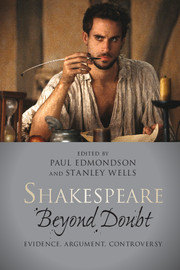Book contents
- Frontmatter
- Content
- List of illustrations
- List of contributors
- General introduction
- Part I Sceptics
- 1 The unreadable Delia Bacon
- 2 The case for Bacon
- 3 The case for Marlowe
- 4 The life and theatrical interests of Edward de Vere, seventeenth Earl of Oxford
- 5 The unusual suspects
- Part II Shakespeare as author
- Part III A cultural phenomenon: Did Shakespeare write Shakespeare?
- Afterword
- A selected reading list
- Notes
- Index
5 - The unusual suspects
from Part I - Sceptics
Published online by Cambridge University Press: 05 April 2013
- Frontmatter
- Content
- List of illustrations
- List of contributors
- General introduction
- Part I Sceptics
- 1 The unreadable Delia Bacon
- 2 The case for Bacon
- 3 The case for Marlowe
- 4 The life and theatrical interests of Edward de Vere, seventeenth Earl of Oxford
- 5 The unusual suspects
- Part II Shakespeare as author
- Part III A cultural phenomenon: Did Shakespeare write Shakespeare?
- Afterword
- A selected reading list
- Notes
- Index
Summary
In April of 1995 the popular science magazine, Scientific American famously published an article by art historian Lillian Schwartz entitled ‘The Art Historian's Computer’. The article advances Schwartz's findings after electronically juxtaposing and superimposing the faces on famous portraits so as to forensically uncover hidden secrets of the past. Comparing da Vinci's Mona Lisa with his self-portrait, for instance, and revealing striking similarities between the two legendary countenances, Schwartz boldly claimed that the former must have been completed with the latter in mind since it so clearly is ‘infused…with his own features’. Among other assertions, Schwartz also adds to the conversation that concerns this collection of essays, a contribution that in itself situates the Shakespeare authorship discussion within the spectrum of the greatest of history's artistic mysteries. Comparing Droeshout's engraving of Shakespeare on the title page of the First Folio with a number of portraits of Shakespeare's contemporaries, Schwartz concluded that the iconic image of the man from Stratford is actually an engraving based on George Gower's ‘Armada’ portrait of Queen Elizabeth I: ‘A detailed comparison on the computer’, Schwartz remarks, ‘revealed that most of the lines in the Droeshout engraving and the queen's portrait by George Gower are the same. The eyes, noses and curvature of the faces match perfectly. But there is an odd shift in some features.’ To reconcile this ‘odd shift’, Schwartz proposes two solutions. First, ‘[i]n having to invent a face for Shakespeare, Droeshout must have based his engraving on a cartoon of the queen's face’, and secondly, because ‘[e]tching metal is hard laborious work,…Droeshout came back to the engraving sometime later…perhaps [after] having finished the left side of the face, and inadvertently (or deliberately) shifted the cartoon’ (italics mine). And finally, while she does not implicitly argue that the plays of Shakespeare were written by the Virgin Queen, she states that ‘lively debates continue as to who wrote Shakespeare's works’ in spite of, or perhaps partly because of her artistic comparison.
- Type
- Chapter
- Information
- Shakespeare beyond DoubtEvidence, Argument, Controversy, pp. 49 - 60Publisher: Cambridge University PressPrint publication year: 2013
- 1
- Cited by



